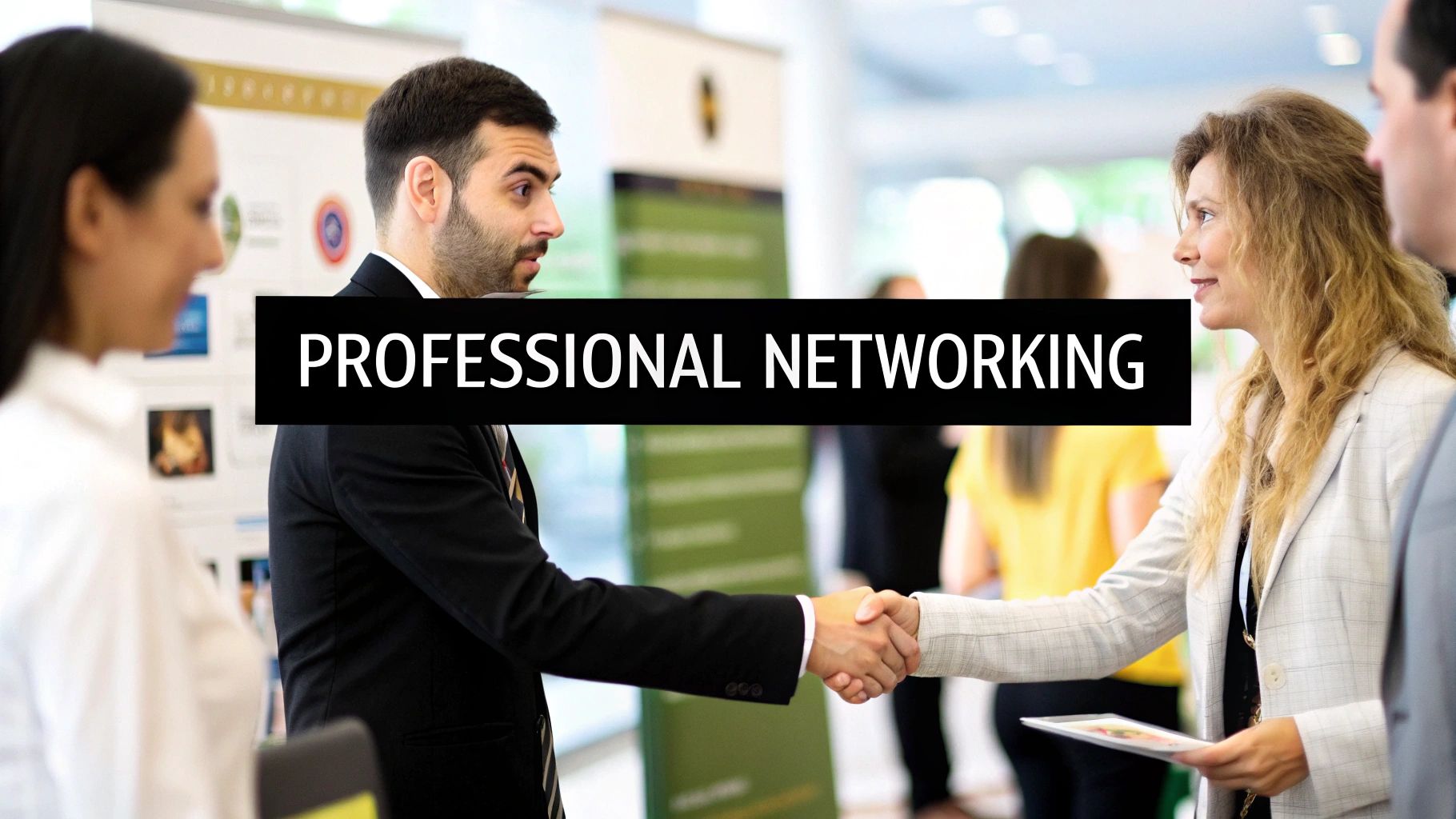
What Is Professional Networking and How to Do It Right
Published on 2025-10-16
Let's get one thing straight: professional networking isn't about collecting business cards or seeing who can rack up the most connections. At its heart, it's the simple art of building real, lasting relationships that help everyone involved move forward.
Think of it like tending to a garden. You can't just throw seeds on the ground and expect a harvest. You have to nurture those connections over time, offering your support and sharing what you know. In return, you get a thriving ecosystem of opportunities, insights, and friendships.
Understanding Professional Networking Today
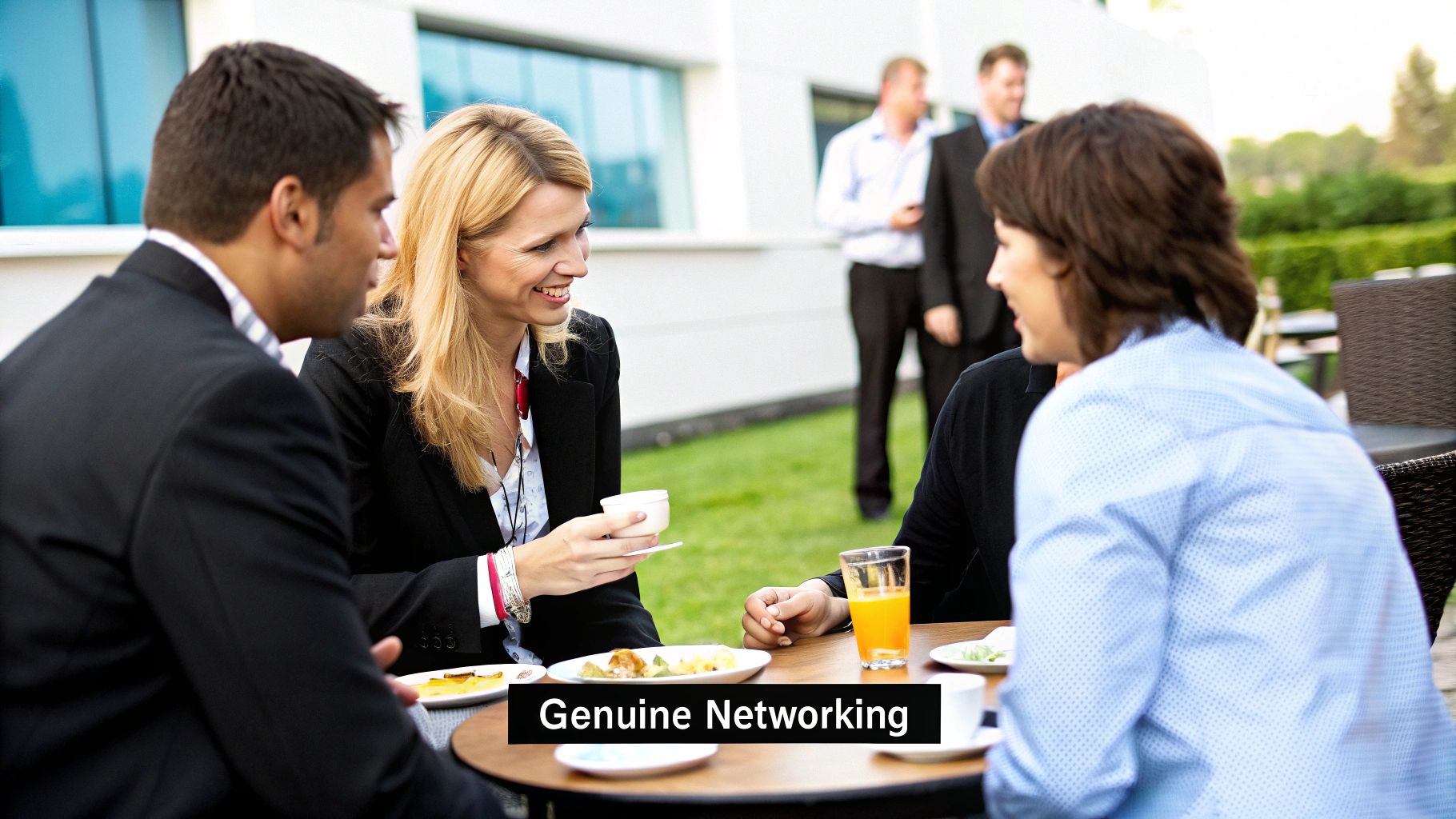
The word "networking" often gets a bad rap. It can bring up images of stuffy corporate events filled with forced, awkward conversations. But that's an outdated picture. Today, it’s all about creating authentic connections based on shared interests and mutual respect, whether you're meeting someone online or grabbing coffee.
This change has been supercharged by platforms that let us connect with people all over the world. LinkedIn, for example, has become an absolute powerhouse for career growth. As of 2025, it boasts over 1.2 billion members, and an incredible 72% of recruiters rely on it to discover talent.
Even more telling, 35% of users say a simple, casual chat on LinkedIn led to a brand-new opportunity. It just goes to show that genuine interactions get real results. For more data on this, check out the full report on Standout CV.
The Mindset of Modern Networking
The real secret to great networking is your mindset. Shift your focus from "What can I get?" to "What can I give?" It completely changes the game. This "give-first" approach turns what feels like a chore into a genuine, collaborative effort.
When you focus on helping others succeed, you naturally build a reputation as someone who is valuable, reliable, and trustworthy.
"True professional networking isn’t about the next badge or the biggest following. It’s about solving the same problem side-by-side until you all get better together."
This really boils down to quality over quantity. A small circle of people you actually trust and engage with is infinitely more powerful than a massive list of connections you barely know. The aim is to build relationships where you can bounce ideas around, ask for advice without feeling weird, and offer support when it's needed.
Here's a quick look at how this modern approach stacks up.
Modern Networking at a Glance
| Core Principle | Primary Goal | Key Outcome |
|---|---|---|
| Give First | Offer value, help, and insights without expecting an immediate return. | Establishes you as a trusted, valuable resource in your field. |
| Build Community | Create a supportive circle of peers and collaborators. | A reliable support system for advice, feedback, and opportunities. |
| Be Authentic | Show up as your genuine self, not a polished corporate persona. | Deeper, more meaningful connections built on trust. |
Ultimately, this isn't just a strategy—it's a more human way to build your career.
Key Principles of Authentic Connection
To really get what professional networking is all about today, keep these core ideas in mind:
- It's a marathon, not a sprint. The best professional relationships aren't made in a day. They're built with slow, steady, and consistent effort over time.
- Reciprocity is the foundation. Strong networks are a two-way street. Value has to flow in both directions for the relationship to thrive.
- Authenticity builds trust. People want to connect with other people, not a carefully curated brand. Just be yourself—it's your biggest advantage.
Why Building Your Network Is a Career Superpower
So, you know what networking is. But the real question is, do you understand why it's one of the most powerful things you can do for your career? It’s not just about swapping business cards or collecting LinkedIn connections. It’s about building a solid foundation for long-term growth and resilience.
Think of your network as your own personal board of advisors. It's a trusted circle of peers, mentors, and industry veterans you can bounce ideas off of, ask for candid advice, or get a fresh take on a tricky problem. This kind of collective wisdom helps you spot opportunities and sidestep challenges you might have never seen coming on your own.
Unlocking Hidden Opportunities
One of the biggest perks of a strong professional network is getting access to the "hidden" job market. Let's be honest, many of the best gigs are filled through referrals and word-of-mouth long before they ever hit a public job board. Your network becomes your eyes and ears on the ground.
And it’s not just about landing your next full-time role. A solid network can lead to all sorts of things—freelance projects, speaking invitations, or even finding the perfect co-founder for a new business idea. Every connection is a potential door to something new.
A study highlighted by Stanford researchers found that learners who shared micro-credentials on professional platforms were 6% more likely to report new employment within a year. The impact was even greater for those without traditional degrees, which just goes to show how a visible network can make your qualifications stand out.
Accelerating Your Personal and Professional Growth
Beyond job offers and project leads, networking is a massive catalyst for your own development. When you talk to people from different backgrounds and with different skills, you're exposed to new ideas and fresh ways of thinking. These conversations are what sharpen your expertise and keep you from getting stuck in a bubble.
This is how you stay relevant. Connecting with an expert in an emerging technology, for example, can give you insights that put you way ahead of the curve. It's a constant learning loop.
As you build these relationships and find ways to help others, you’re also building your personal brand. You start to become known for what you know, your reliability, and your willingness to chip in. That reputation is gold. To really cement your influence, you have to learn how to be a thought leader by consistently sharing your unique point of view.
At the end of the day, networking gives you more than just a list of contacts; it gives you confidence. Knowing you have a community to fall back on makes taking those calculated career risks feel a lot less scary. That feeling of support is what turns a simple career into a truly dynamic and rewarding journey.
Mastering Your Online Networking Game
Let's face it, in our world, your first handshake is often a digital one. This means knowing how to connect with people online isn't just a nice-to-have skill; it's essential. Platforms like LinkedIn are the new conference halls, and building real relationships from behind a screen is the name of the game. It’s time to stop just having a profile and start using it to attract genuine opportunities.
The secret? Act like a person, not a robot. Generic connection requests and those bland "great post!" comments are the online equivalent of a limp handshake. They're forgettable. The real goal isn't to rack up a massive list of contacts you don't actually know; it's to build a high-quality network of meaningful connections.
Everything starts with a solid foundation. Before you even send that first message, your profile needs to tell a compelling story. Our guide on how to build a LinkedIn profile that stands out is a great place to start, walking you through how to create a presence that naturally invites people to connect.
Crafting a Connection Request That Actually Works
The single biggest mistake I see people make? Sending a connection request with no personal note. It’s a huge missed opportunity to kick off a real conversation.
A great request is simple, direct, and specific. It needs to answer one question for the person on the other end: "Why are you connecting with me?"
Here are a few quick tips for writing a request that gets a response:
- Point out a shared interest: "I saw your recent post on the future of AI in marketing and found your perspective on data privacy fascinating."
- Mention a mutual contact: "Our mutual connection, Jane Doe, mentioned you're the go-to expert in SaaS sales."
- Show you've been paying attention: "I've been following your work for a while and was really impressed by the case study you shared on the XYZ project."
This tiny bit of effort shows you've done your homework and value their time, which dramatically boosts your chances of getting a "yes."
The data below shows just how much of a difference a little personalization can make.
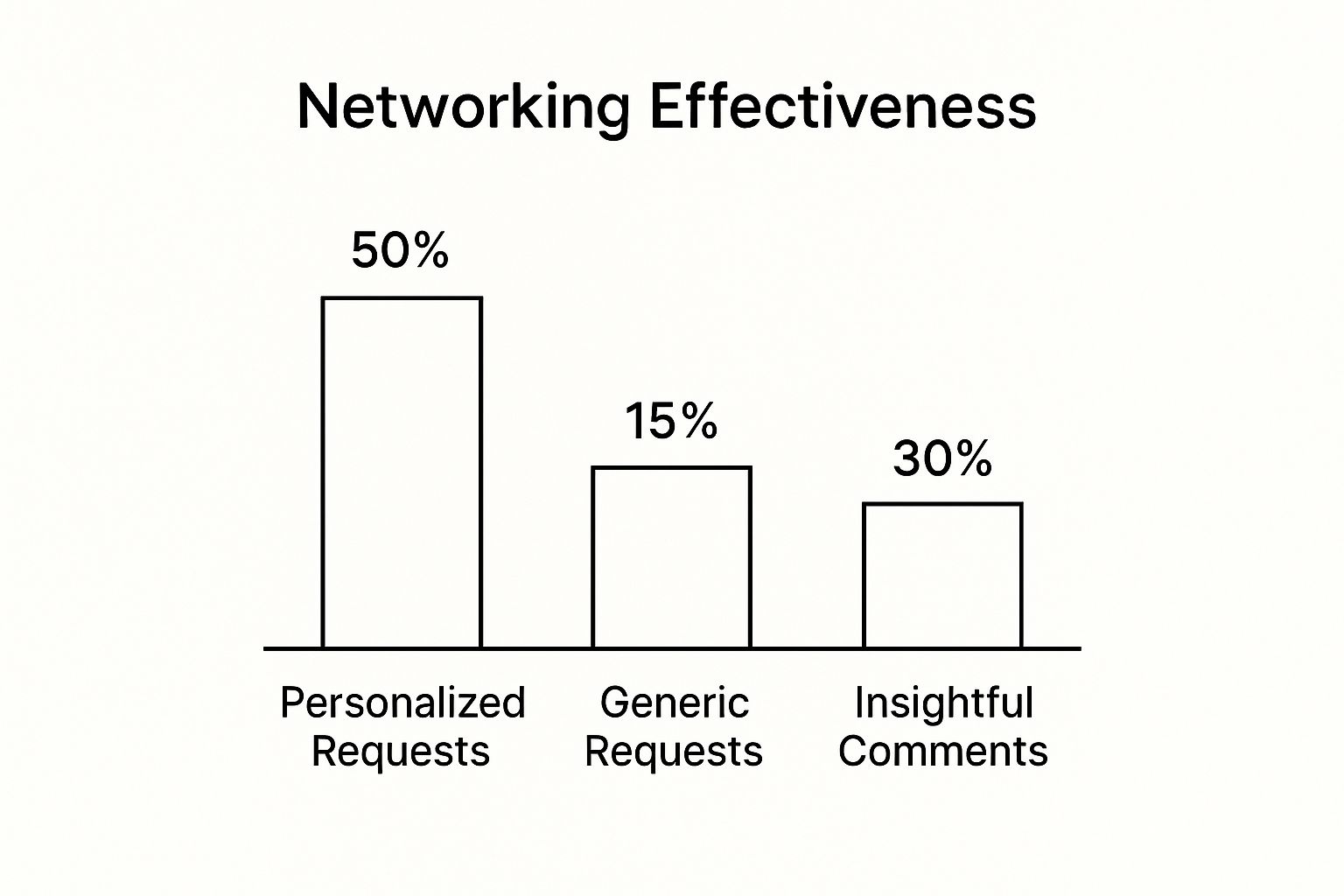
As you can see, taking a moment to customize your request more than triples your effectiveness. It's a small investment with a huge return.
From Commenter to Collaborator
Engaging with other people's content is one of the most powerful—and most overlooked—networking tools out there. Don't just "like" a post and move on. Leave a thoughtful comment that actually adds to the conversation.
Ask a smart question, share a relevant insight from your own experience, or respectfully offer a different point of view. This simple act positions you as a valuable contributor, not just another face in the crowd.
The goal of an online interaction isn't to close a deal on the spot. It's to open a door to a future conversation.
The role social media plays in networking is only getting bigger. Projections show that nearly two-thirds of the world's population will be active on these platforms by 2025. People are already spending an average of 141 minutes a day across 6.84 different platforms, which creates endless opportunities for you to make a real professional connection.
If you're looking to take your online presence to the next level, exploring different strategies for enhancing social media engagement can make a significant difference in your networking efforts.
Making Real Connections in the Real World
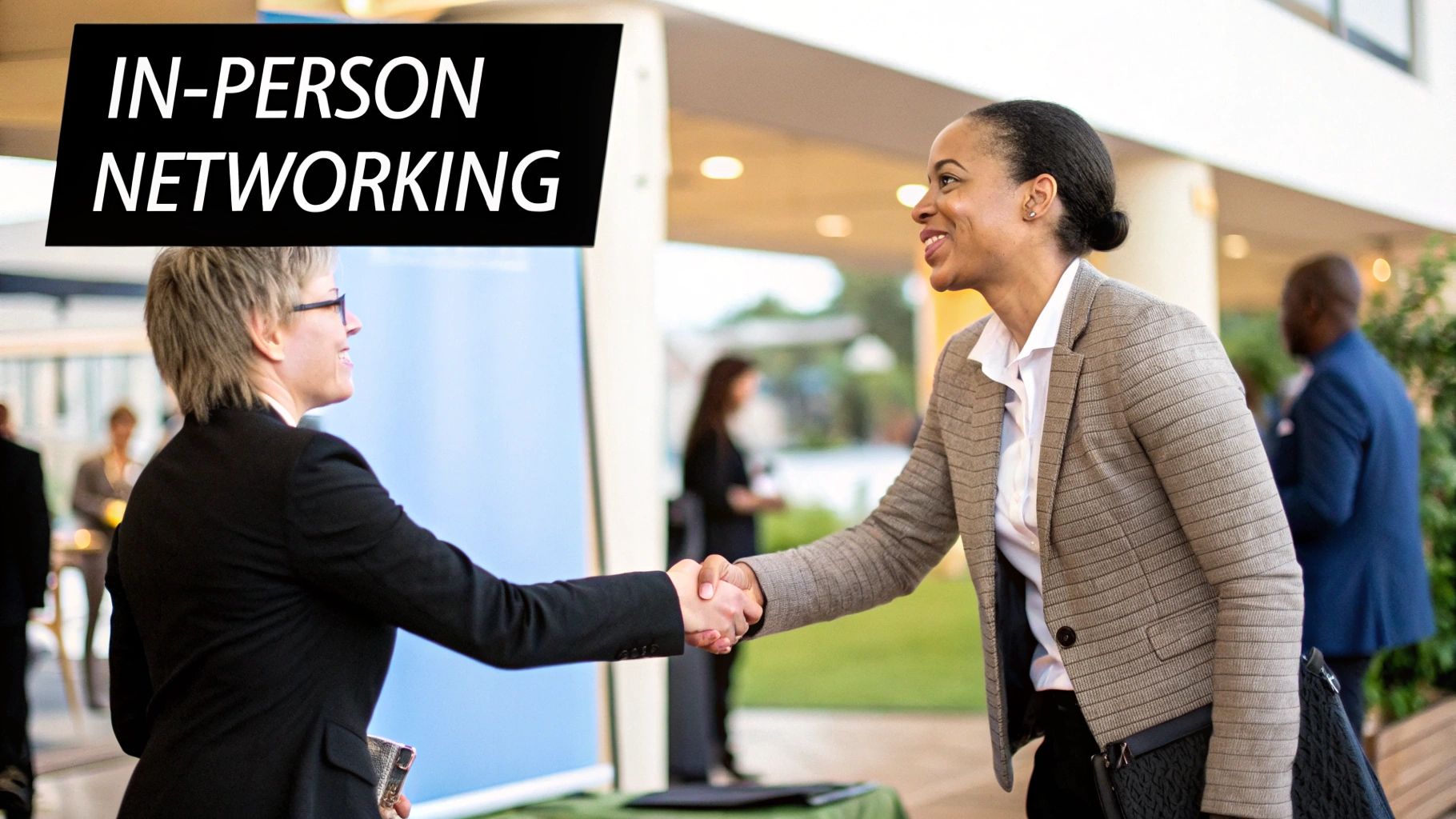
As powerful as your digital presence is, there’s a certain magic that happens when you connect with someone face-to-face. Nothing fully replaces the energy of a real-life conversation at a conference, a local meetup, or even a community event.
It’s in these moments that you build a different kind of trust. You can read body language, share a genuine laugh, and create a human connection that’s much harder to forge through a screen. Think of it like this: an in-person meeting plants a seed. The follow-up is what helps it grow.
How to Navigate In-Person Events with Confidence
Walking into a room full of strangers can feel intimidating. I get it. But the secret is to shift your goal from "talk to everyone" to "have a few great conversations." It’s about quality, not quantity.
If you find these big social settings a bit draining, don't worry—you're not alone. You can find some fantastic, practical tips on how to network as an introvert that make these events feel less overwhelming and far more rewarding.
A big part of feeling confident is simply being prepared. Knowing how to introduce yourself clearly and concisely is a game-changer. I’d recommend checking out these powerful elevator speech frameworks to help you nail down an intro that feels authentic to you.
To make sure your conversations land, focus on these three simple things:
- Listen More Than You Talk: The best networkers are almost always the best listeners. Ask thoughtful, open-ended questions and be genuinely curious about the other person.
- Look for Common Ground: Try to find a shared interest or a professional challenge you both face. That’s what turns a polite introduction into a real, memorable conversation.
- Have a Graceful Exit Plan: Knowing how to end a conversation is just as crucial as starting one. Something as simple as, "It was so great talking with you! I'll connect on LinkedIn so we can stay in touch," works perfectly.
Don't Forget the Follow-Up (It’s Everything)
Here’s where most people drop the ball. You have a great chat, exchange business cards, and then… crickets. Meeting someone is just the beginning. The follow-up is what turns that brief encounter into a real relationship.
A quick, personalized follow-up within 24-48 hours is the difference between being remembered and being forgotten. It proves you were listening and that you value the connection.
Keep your message short and sweet. Mention something specific you talked about to jog their memory—for example, "Loved our chat about the new AI tools for content creators." You’re not asking for anything yet; you’re just reinforcing the connection. If you can, offer a piece of value, like an article related to your discussion. This simple gesture of giving first builds a strong foundation for whatever comes next.
Your Action Plan for Authentic Networking
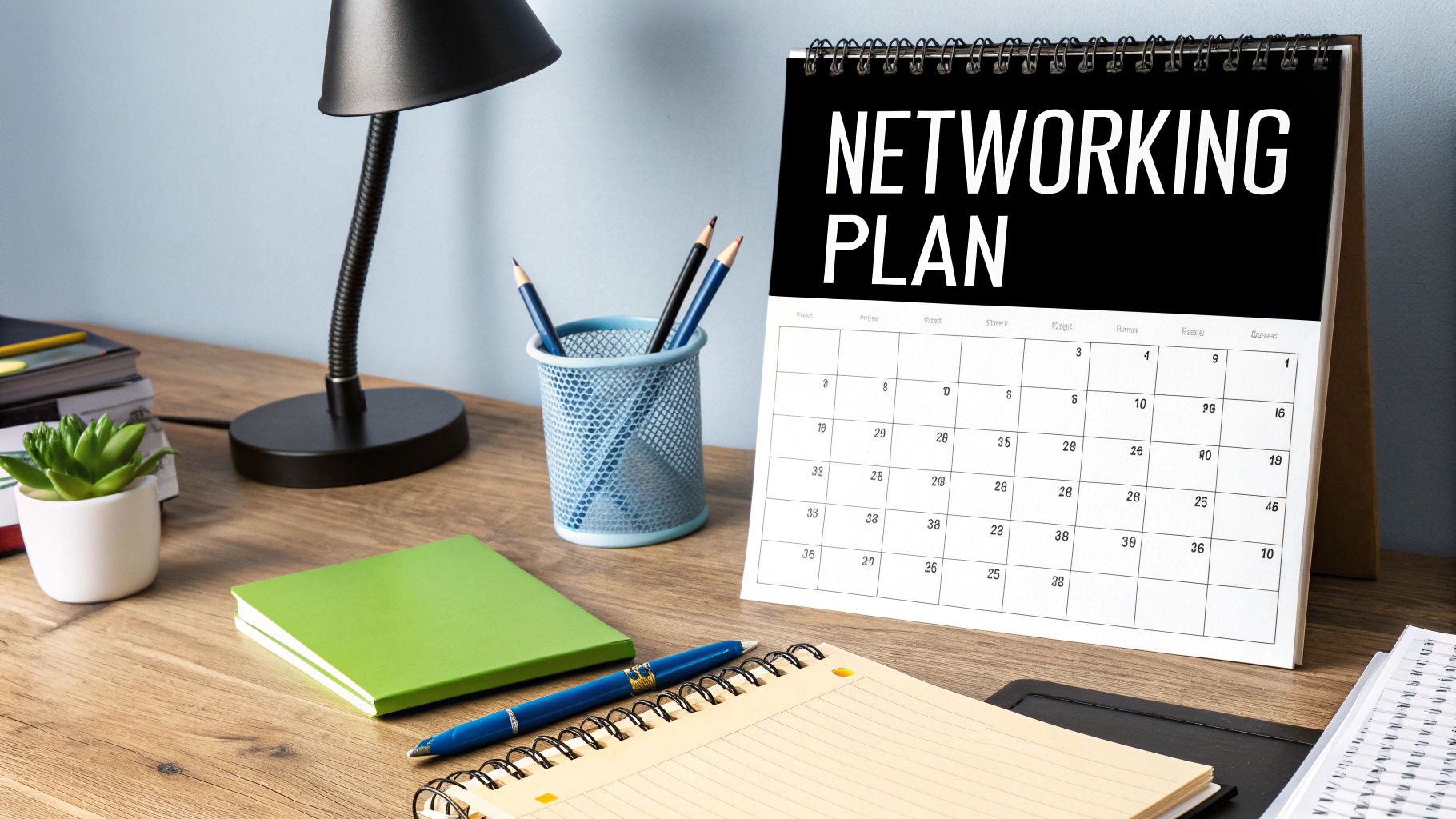
Knowing the theory is one thing, but actually doing it is where the magic happens. This is your playbook for building real relationships without getting overwhelmed. The aim is to create a simple, repeatable strategy that folds right into your daily routine, turning networking from a chore into a habit.
The secret is to start small. Big, fuzzy goals like “grow my network” are intimidating and impossible to measure. Instead, we're going to focus on clear, bite-sized actions. This approach takes a vague wish and turns it into a concrete to-do list that actually gets you somewhere.
Think about it like this: you wouldn't try to run a marathon on your first day of training. You'd start with a short jog and build up. The same exact logic applies here.
Define Your Networking Goals
Before you start sending connection requests, hit pause. What are you actually trying to accomplish? Are you looking for a mentor? Trying to break into a new industry? Maybe you're hoping to find a collaborator for a new project.
Your goals dictate who you connect with and how you start the conversation.
Get specific by setting "micro-goals" you can easily track.
- Example 1: Have two virtual coffee chats this month with people in my target industry.
- Example 2: Leave a thoughtful comment on three relevant LinkedIn posts each week.
- Example 3: Reconnect with one former colleague every two weeks, just to see how they're doing.
These small, consistent efforts are the bedrock of a strong network. They keep you in the game without demanding huge blocks of your time, making the whole process feel manageable and effective.
Lead with the Give First Principle
If you only take one thing away from this guide, let it be this: be generous. The most powerful mindset you can adopt is to approach every new connection thinking, "How can I help this person?" instead of, "What can I get from them?"
This "give before you get" philosophy is the fastest way to build trust. It immediately positions you as a valuable, supportive person people want to know.
Adding value doesn't have to be some grand gesture. It can be as simple as sharing a useful article, offering a helpful piece of feedback, or making a thoughtful introduction to someone else you know.
True networking is a marathon, not a sprint. By consistently offering value without expecting anything in return, you build a reputation that opens doors you never knew existed. It’s a long-term investment in professional goodwill.
This mindset is more important than ever. The global market for networking support services is projected to hit USD 924.16 billion by 2024, which just shows how much modern business relies on interconnected systems. Your personal network runs on the exact same principles of mutual support. You can read more about these market trends on Business Wire.
Put It All Together
Think of this action plan as a starting point, not a rigid set of rules. Feel free to tweak these steps to fit your personality and your career goals.
- Identify 5-10 Key People: Who do you admire? Who is doing the kind of work you want to do? Make a short list.
- Engage Authentically: Follow them on LinkedIn. Don't just be a silent observer—start by adding thoughtful comments to their posts.
- Offer Value: Find a small, genuine way to be helpful. Maybe you can share a resource or an insight they might appreciate.
- Send a Personalized Request: After you've built a little bit of familiarity, send a connection request that references your previous interaction. No generic templates!
- Nurture the Relationship: Once you're connected, keep engaging with their work. Always be on the lookout for small ways you can support them.
This simple, repeatable process takes the mystery out of what professional networking is and gives you a clear path to follow.
Got Questions About Networking? We've Got Answers.
Let's be honest, even when you know why you should network, the how can still feel a little tricky. That's completely normal. Below, I’ve tackled some of the most common questions and worries I hear from people, breaking them down into simple, practical advice to help you connect with more confidence.
Think of this as your go-to guide for navigating those real-world situations. The goal isn't just to network, but to build relationships that actually feel supportive and genuine.
How Do I Network if I’m an Introvert?
This might sound counterintuitive, but being an introvert can be a networking superpower. Why? Because introverts are often incredible listeners. Forget the stereotype of working a crowded room. Your strength lies in creating meaningful, one-on-one connections.
Start where you feel most comfortable. The online world is a great place to begin because it gives you the space to think and compose your thoughts without the pressure of an immediate response. Set small, achievable goals to build your momentum.
- Aim to connect with one new person on LinkedIn each week.
- Find one small, focused virtual event or meetup each month on a topic you’re passionate about.
- Before a call or meeting, jot down a few open-ended questions to help kickstart the conversation.
Remember, this isn't about being the loudest voice. It’s about making a real connection. Your natural ability to listen intently and think deeply is exactly what makes people feel seen and heard—a rare and valuable skill.
What’s the Best Way to Follow Up After Meeting Someone?
A quick, personal follow-up is non-negotiable. It’s the single best way to turn a brief encounter into a lasting connection. Try to send a LinkedIn message or a short email within 24-48 hours of your conversation. This simple act keeps you top-of-mind and shows you were genuinely engaged.
The trick is to make it specific. Reference a particular part of your chat to instantly remind them who you are. Instead of a generic "Nice to meet you," try something like, "I really enjoyed our conversation about the future of AI in marketing." It proves you were actually listening.
Your follow-up is about continuing the conversation, not making an immediate ask. The goal is to build the relationship. Offer a little value first—maybe share that article you mentioned or a resource you think they'd find helpful. An authentic, helpful message always wins.
How Can I Network Without Feeling Slimy or Selfish?
This is a big one. So many people worry that networking is just about taking. The secret is to flip your perspective entirely. Stop thinking, "What can I get from this person?" and start asking, "What can I give?"
Real, effective networking is rooted in generosity. It's about a mutual exchange of value. Before you even think about asking for something, look for small ways to help the other person out. It could be as simple as sharing one of their posts, offering a thoughtful comment on their work, or introducing them to someone in your circle who could help them.
When you lead with a genuine desire to help others and learn from them, that "slimy" feeling completely disappears. It stops being a transaction and starts being a truly rewarding part of your professional life.
How Often Should I Be Networking to Actually See Results?
Consistency trumps intensity, every single time. You don't need to block out entire days for networking events. It’s the small, steady actions that build strong, lasting relationships over time.
Try to weave networking into your weekly routine. Just 15-30 minutes a few times a week is all it takes to make a real impact. You could use that time to engage with a few interesting LinkedIn posts, send a quick "thinking of you" email to an old colleague, or schedule one virtual coffee chat. This low-pressure approach keeps your connections warm and makes networking feel like a natural part of your day, not another chore on your to-do list.
Ready to build your professional brand and create content that starts conversations? autoghostwriter uses powerful AI to help you craft engaging LinkedIn posts that build your network. Stop staring at a blank screen and start connecting. Create your first post for free.